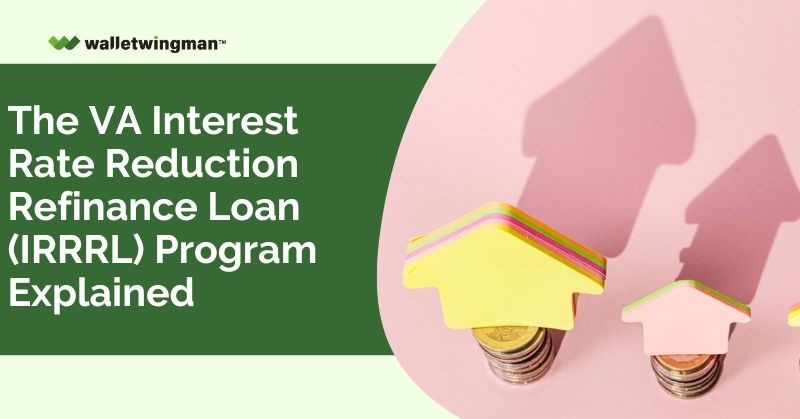In this article: An overview of the VA Interest Rate Reduction Refinance Loan (IRRRL) program and the benefits it can provide for homeowners.
We’ve written extensively about the VA home loan program, including its many benefits. One of those benefits is refinancing.
With a VA-backed Interest Rate Reduction Refinance Loan (IRRRL), homeowners can reduce their VA IRRRL rates of interest and lower their monthly payments. This program allows refinancing homeowners to skip the home appraisal and credit underwriting.
What Is the VA IRRRL Program?

The VA IRRRL program offers a streamlined mortgage refinancing option to eligible homeowners. It is designed for military members and veterans with a VA home loan for a current or previous residence.
The primary goal is to lower the interest rate and monthly mortgage payments, hence the name: Interest Rate Reduction Refinance Loan.
Mortgage professionals often refer to the IRRRL program as a “streamline” refinance. That’s because it offers a more straightforward refinance path than a regular (non-VA) refinance loan.
Specifically, an Interest Rate Reduction Refinance Loan allows homeowners to refinance with little paperwork and no VA home appraisal. Mortgage lenders can also skip the typical credit check required for most home loans.
Benefits of an Interest Rate Reduction Refinance Loan
So, the benefits of this program are twofold:
- It gives homeowners a way to secure a lower interest rate, reducing their monthly payments in the future.
- It also makes it a lot easier to VA loan refinance when compared to a conventional home loan scenario.
It offers eligible homeowners a way to reduce their rates, potentially resulting in significant savings over the life of the loan.
Homeowners can also use the Interest Rate Reduction Refinance Loan to switch from an adjustable-rate mortgage (ARM) to a fixed-rate with more stable payments. As you might already know, a fixed mortgage has an interest rate that never changes and, therefore, offers more predictability over the long run.
Moreover, veterans can leverage the VA cash out refinance option to access their home equity for various financial requirements, such as home improvements, debt consolidation, or educational expenses.
VA Cash-Out Refinance

VA cash-out refinance is a unique program offered to eligible veterans, allowing them to tap into their home equity and convert it into cash. Unlike traditional refinancing options, which typically aim to secure better loan terms or reduce interest rates, VA cash-out refinance enables homeowners to borrow against the equity they’ve built up in their homes.
This additional cash can be used for diverse purposes, including home improvements, debt consolidation, educational expenses, or other financial needs. One significant advantage of VA cash-out refinance is that it allows veterans to access funds at potentially reduced interest rates compared to other types of loans, thanks to the VA’s guarantee.
However, it’s important to carefully consider the implications of increasing your mortgage balance and ensure that the advantages outweigh the costs and risks associated with refinancing.
Eligibility requirements, loan limits, and other factors may apply, so veterans considering a VA cash-out refinance should consult with a VA-approved lender to explore their options and determine if it’s the right choice for their financial situation.
How the IRRRL Works
When you refinance your home through the IRRRL VA loan program, you’re essentially replacing your existing home loan with a new one that (ideally) has a lower interest rate.
But the Department of Veterans Affairs only plays a background rule in this process. When seeking an Interest Rate Reduction Refinancing Loan, you’ll need to work with a VA-approved mortgage lender, just like you did when you first purchased the home.
IRRRL refinancing typically comes with VA closing cost as well. So you want to make sure that the amount of money you save over the long term surpasses whatever amount you have to pay in closing costs. Otherwise, it might not work to your advantage.
According to the Department of Veterans Affairs, the closing costs associated with an IRRRL transaction typically include the following:
- Origination Fee: This fee includes the administrative costs of processing the VA loan application and is charged by the lender.
- Discount Points: These are upfront fees paid to the lender at closing to decrease the interest rate on the loan.
- Prepaid Taxes and Hazard Insurance: Borrowers typically need to prepay a portion of their property taxes and hazard insurance premiums at closing.
- Title Examination Fee: This fee covers the price of examining public records to confirm the legal ownership of the property and make sure there are no outstanding liens or title issues.
- Title Insurance Fee: Title insurance protects both lenders and homeowners against financial losses resulting from defects in the property’s title or ownership.
- Flood Zone Determination: This fee covers the cost of deciding whether the property is located in a designated flood zone.
- Environmental Endorsements: These endorsements ensure that the property complies with environmental regulations and is free from contamination or hazardous conditions.
- Recording Fees: The recording fees are charged by local government offices for recording the mortgage and deed documents in the public records.
- Special Mailing Fees (Fed-Ex, couriers, etc.): Additional fees may be incurred for expedited or special mailing services, such as overnight delivery or courier services.
- VA Funding Fee: The VA funding fee is a singular payment made to the Department of Veterans Affairs, which aims to bolster the financial resources of the VA loan program.
About the Funding Fee

While some exceptions exist, most VA loan borrowers must pay a one-time funding fee. This is true for both purchase and refinancing situations. The Department of Veterans Affairs uses these fees to help finance the program and reduce the burden on taxpayers.
The good news is that the Interest Rate Reduction Refinance Loan funding fee is typically lower than the fee associated with a standard VA-purchased loan. It usually amounts to 0.5% of the new loan amount.
Homeowners can either pay the IRRRL funding fee upfront at the closing or finance it and pay it off over time. So, there is some flexibility here as well.
Additionally, borrowers considering an IRRRL should explore current VA streamline refinance rates to assess potential savings and determine the feasibility of refinancing their existing VA loan. Understanding these rates empowers borrowers to make informed financial well-being and loan management decisions.
Who Can Benefit From This Program
The VA Interest Rate Reduction Refinance Loan program can benefit many homeowners. But it’s not suitable for everyone. For example, a homeowner who plans to move again in a few years probably won’t benefit from refinancing.
On the other hand, a person who plans to stay in the home for many years after refinancing could enjoy long-term savings by reducing their interest rate.
Additionally, homeowners with an adjustable-rate VA loan that’s about to adjust could benefit by refinancing into a fixed-rate mortgage. This can also be accomplished through the IRRRL program.
Minimum Requirements for Borrowers

This program is only available to homeowners who used a VA loan to purchase their homes. When applying for an IRRRL, you must certify that you previously lived in the house.
It’s worth reiterating: The Interest Rate Reduction Refinance Loan (IRRRL), commonly known as the VA streamline refinance, can exclusively be utilized to refinance an existing VA loan. This program does not extend to refinancing conventional mortgages.
The mortgage lender must verify that your monthly payment will decrease after refinancing since that’s the whole point of this program. However, there are some exceptions to this requirement, particularly when refinancing out of an ARM into a fixed-rate mortgage.
The Department of Veterans Affairs does not require credit underwriting for IRRRL scenarios. However, you will probably have to meet the lender’s basic standards.
The occupancy requirements for the Interest Rate Reduction Refinance Loan program differ from the standard VA purchase loan rules.
Homeowners who use a VA loan to buy a house must certify that they intend to occupy the home as their primary residence. But as the Department of Veterans Affairs states: “For an IRRRL, you only need to certify that you previously occupied [the home].”


